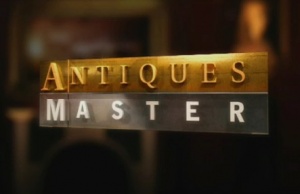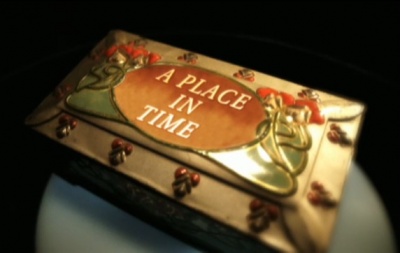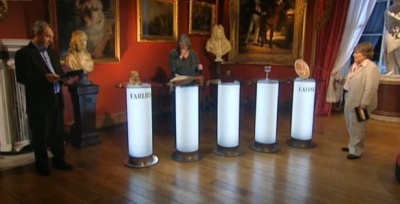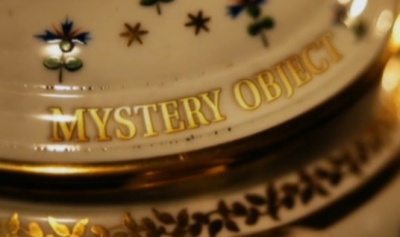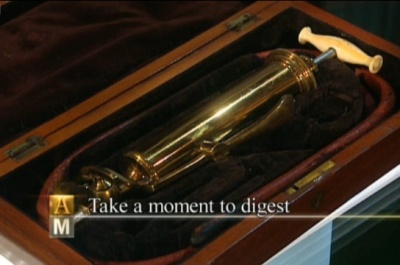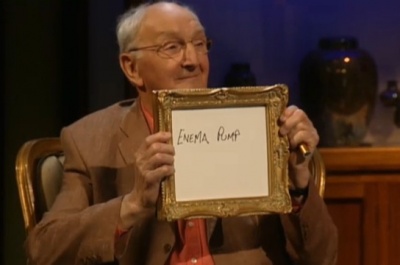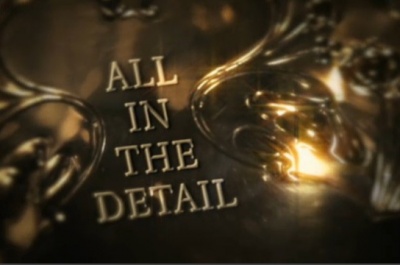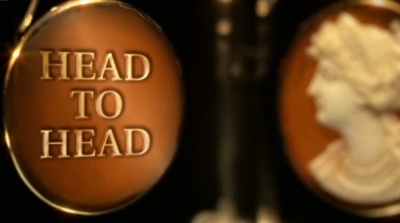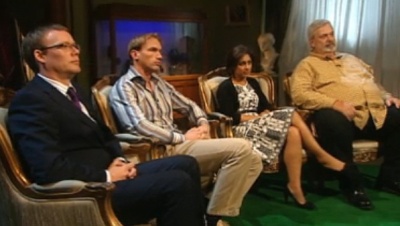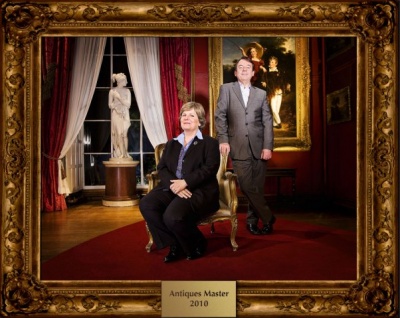Antiques Master
Contents |
Host
Co-hosts
Voiceover:
Anna Chancellor (2010)
Melissa Sinden (2011)
Broadcast
BBC Manchester for BBC Two, 5 July 2010 to 19 September 2011 (21 episodes in 2 series)
Synopsis
Hello. I'm Anna Chancellor - you might remember me from the hit BSB Galaxy soap opera "Jupiter Moon". On this page, a reviewer from UKGameshows.com is going to attempt to review "Antiques Master", which I also narrate.
Quiz seeking Britain's most knowledgeable amateur antiques expert, featuring a mixture of hands-on and straight quiz rounds. Considering how many antiques and collectables programmes clutter up the schedules nowadays, it's somewhat strange that there hasn't really been a proper knowledge-based antiques quiz since the 1990s revival of Going for a Song. And for a show testing members of the public, you would have to go back to the non-tournament The Great Antiques Hunt. In short, Antiques Master is surely an idea that was overdue a turn.
The programme has been set in its historic context. Now the reviewer must describe the rounds and place them in the correct order. The rounds are "A Place in Time", "Head to Head", "Mystery Object" and "All In The Detail".
Round one is A Place in Time, which is very much a Great Antiques Hunt type of game: five objects (one of which is very valuable, though this has no actual bearing on the round) are placed on podia, and the contestants are brought in one at a time to identify them and rearrange them in chronological order (though the four players' attempts are all cut together in the edit). They get five points for each item correctly placed.
The reviewer has correctly identified that "A Place in Time" is the first round, and gets five points.
The second round is Mystery Object. Each contestant is given a mystery object and an oblique clue to what it is.
They get 10 points if they correctly identify it; meanwhile the other contestants also attempt to identify it by writing their answers on boards. If the contestant whose item it is fails to identify it, then the others get to hold up their boards and score 5 points for a correct answer.
After this round, the lowest-scoring player is eliminated (should a tie-break be required, the tied players are asked to provide an auction estimate for one of the items from round one) and the others move on to the third round...
All In The Detail, which is a "specialist subjects" round. (You'll notice that this structure means that a specialist round needs to be prepared which won't ultimately be used.) Back to the podia, and this time each player is presented with five items from their own area of expertise. They have to pick out the oldest, the most valuable, and the "odd one out" (they're given an indication of the way in which the odd one out differs from the rest - typically being a reproduction or made in a different country).
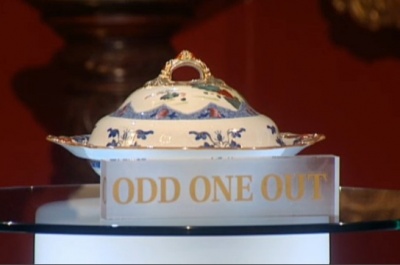 That's a different show altogether
That's a different show altogetherThey get ten points for each they successfully pick out, plus another ten for providing an auction estimate for the most valuable item which agrees (to within 10%) with the one on Eric Knowles' card. Since auction estimates are notoriously unreliable (as anyone who's seen any of the billion or so other antiques shows on the telly knows), this is really somewhat pot luck. Anyhow, the two highest-scoring players after this round go through to the final round.
The reviewer has successfully placed the the first three rounds in order, but can she get the fourth correct as well? I know the answer is obviously yes, by the way, but I actually used this as a point of suspense in the first show and I'm hoping that if I make a feature of it, nobody will notice how silly it is.
The final round is Head to Head, which is a straight Q&A buzzer round - supposedly lasting 90 seconds, though the show spends so long on pointless narrative recaps that they show less than a minute of this round in the final edit. Which is a bit stupid.
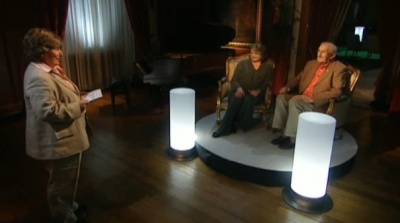 Oooh, it's all gone a bit Mastermind
Oooh, it's all gone a bit MastermindThe reviewer has identified a flaw in the show's production. This will help her in assessing the show's strengths and weaknesses.
There's no doubting that the show's central premise is basically good. But the presentation leaves a lot to be desired. No quibbles with Eric Knowles - he knows the subject inside out and communicates his knowledge and enthusiasm well, just as he always has on Antiques Roadshow and used to on Going For a Song. Sandi Toksvig is not exactly an obvious choice for host, but isn't a disaster. Eric's the expert, so all Sandi needs to be able to do is verbally prod the contestants without giving any information away, and she does that perfectly well.
The reviewer has assessed the contribution of the on-screen hosts and now needs to assess the other aspects of the production.
However, one aspect that really doesn't work at all is the Masterchef style narration by Anna Chancellor.
The reviewer is criticizing my narration, which she thinks is similar to India Fisher's commentary on "Masterchef".
There are certainly elements of this show which require a voiceover - well, there's one element really, that being the initial descriptions of the items in the first round. And even that would be much better handled by the host than by a separate voiceover artist. The rest is pointless commentary, as if we're watching a report on a game show, rather than the game show itself.
The reviewer thinks my commentary is pointless, apart from the initial descriptions of the items in the first round, and even...
SHUT UP ANNA!
Is she gone?
Phew.
Well, you see what I mean. It's not the only issue with this show, but it's a pretty big one. They've also rather overestimated the appeal of the venue, Towneley House in Burnley - a fine manor, certainly, but install a game show set in a country house and it tends to end up looking like a TV studio no matter what you started with (cf. Millionaire Manor, Watching the Detectives, the BBC2 revival of Treasure Hunt), which leaves you wondering whether it was worth the bother.
The "mystery object" round doesn't really work, as the clues are either ridiculously transparent or ridiculously opaque, and pretty cringemaking whichever way they go, and we can't begin to imagine why anyone thought it would be a good idea to have an elimination before the specialist round, as if there is one round you would expect all the contestants to be given an opportunity to shine in, that's the one. (There's an obvious solution, too - just swap the first and third rounds. After all, leading with a specialist round never hurt Mastermind.) The 2011 series, which we'll get to in a moment, has at least dealt with both of these issues.
Also, this a just a little thing, but considering how much other shows have been mocked for describing a contest as a "journey", it beggars belief that this show still uses the word without a hint of irony - especially when you consider that the contestants' "journey" is a not-particularly arduous trek into the next room and back.
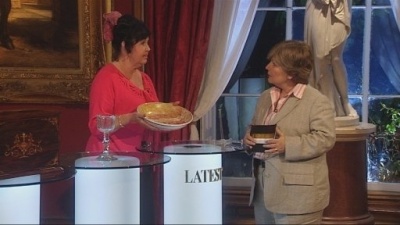 Contestant Lynne Hardman telling Sandi Toksvig about a William de Morgan bowl worth thirty thousand pounds.
Contestant Lynne Hardman telling Sandi Toksvig about a William de Morgan bowl worth thirty thousand pounds.The sad thing is, Antiques Master should work. It's got an authoritative and personable expert (Knowles, not Toksvig) at the centre of things, contestants eager to show off their genuine knowledge and enthusiasm, a lot of care taken in behind-the-scenes research, and even the odd "wow" moment when it's revealed that the contestants have just been handling some insanely expensive objet d'art. But the presentation let it down so badly that we fully expected the show to get the chop after its initial run.
It did return in 2011 with a few tweaks, though maybe not the tweaks we'd have made. All the rounds now use the five podia, which gives them either a visual unity or an unfortunate sameyness. There are three contestants in each episode, and only three rounds, with the specialist round first. The only internal change to the round is in the "auction estimate" bonus which now has a margin of 15%, and (now being requested after Eric reveals the most valuable item) is worth 10 points if the contestant identified the most valuable object correctly, and 5 points otherwise. "A Place In Time" follows, and then the two top-scorers play the head-to-head, which has also undergone a change: the podia are replenished with fresh objects, and answering a starter question correctly entitles the contestant to select one of the objects and get first shot at the attached question (it can however be passed across if the original contestant fails to answer correctly). Anna Chancellor has vanished, but only to be replaced by another voiceover artist, so no improvement there. And the J-word still puts in an appearance. Overall, it still falls significantly short of what it could be and with the BBC not exactly straining themselves to promote the show, it seems unlikely to get a second reprieve.
This is the end of the review. For all your voiceover and upper-middle-class female, 35-55, character portrayal needs, look for Anna Chancellor in "Spotlight".
Trivia
Filmed at Towneley Hall in Burnley, Lancashire.
The last episode of series 1 was a celebrity edition in which TV doctor Christian Jessen (specialism: 18th and 19th century bronzes) beat Geoff Capes (Lalique glassware), Saira Khan (victorian furniture) and Ricky Groves (fishing tackle).
Champion
2010: Sue Hirons
2011: Sandy Rich
Music
Paul Farrer

